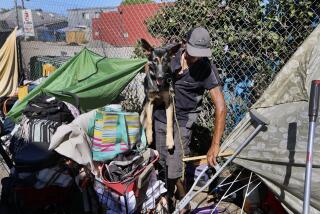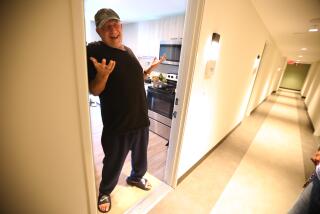Fleeting Limelight Fails to Brighten Lot for Homeless Shelter
- Share via
LONG BEACH — The Long Beach Family Shelter for the Homeless began its role as a media darling with a phone call. It was the night before “Hands Across America,” and organizers were looking for a “typical” homeless family to form the last link in their 3,200-mile human chain ending at the Queen Mary. Sally Chupool, director of the facility, suggested Bill and Mary Jones, a couple with five children then staying at the shelter.
What happened next is legend among those now staying at the 45-bed facility that served as a temporary home to 224 families last year. The Joneses made the shelter famous. And the shelter made the Joneses famous. Now the family has moved on and so have the cameras. And while the rest of the country looks to fresher subjects, it’s business as usual at the shelter in the former hospital building at 14th Street and Chestnut Avenue.
Though the average stay is two weeks, Chupool said, some residents remain as long as 30 days while searching for jobs and housing. In addition to providing them with clean rooms, she said, the shelter provides three meals a day, various counseling services and free day care for children.
But for the shelter’s residents, searching for permanent quarters can be difficult.
“I’d rather live five miles from the Ku Klux Klan than go through this,” said Connie Randolph, 35, a black woman who came from Louisiana two weeks ago with her 7-year-old daughter looking for a new life and an affordable apartment.
So far she has found neither.
“When they find out you live in the shelter, they act like you have leprosy,” she said of the landlords who have interviewed her. “If it weren’t for the people in here I’d be a raving lunatic.”
Shelly Martinez, an unemployed lab technician evicted from her home because she could no longer pay the rent, added, “After a while it gets tedious.”
Despite the publicity generated by Hands Across America, Chupool said, the facility is in desperate need of funds. Although individual contributions since the event have gone from $15 a week to about $100--up nearly 600%--that money forms only a minuscule portion of the shelter’s annual budget, she said.
Of the $157,460 the shelter spent in 1985, about $114,000 came from the county, with the rest--about $43,500--provided by Catholic Social Charities and United Way, said Dick Langevin, director of Catholic Social Charities, which acts as the facility’s fiscal agent.
This year the numbers have shifted: Of the projected 1986 budget of $158,793, Langevin said, the county has cut its contribution to $98,539, thereby forcing the local agencies to take up the slack by increasing their contribution to $60,254. Thus in one year, Langevin said, the local contribution has grown from 28% to 38% of the total budget, while the county’s portion has slipped from 72% to 62%.
“The money hasn’t been coming in as well as we’d hoped,” Langevin said.
And even if it had, he said, the relatively static budget over the past two years has not kept pace with the increased costs of and demands for services associated with the shelter.
“I would characterize our situation as desperate,” said Chupool, who noted that the shelter now receives an average of five requests for shelter per day compared to one or two a year ago.
Leah Koortbojian, who represents the Jewish Family Service on a coalition of local agencies governing the shelter, said, “I question how long (the facility) can be sustained under such circumstances.”
The Jones family, meanwhile, has dropped out of sight.
Got Several Job Offers
In the aftermath of the publicity they received, Bill Jones got several job offers, one of which he ultimately accepted. And a few weeks later, when they were approaching the maximum 30-day limit allowed in the shelter, a generous Torrance couple found a vacant apartment for the family and gave them $1,000 to pay for the first and last months’ rent.
Then things took an unexpected turn. Bill Jones decided that his real destiny lay in Spokane, Wash., a city he had once passed through while hitchhiking. So he quit his new job, spent some of the donated money on bus tickets, and shunted his family north, Chupool said.
“They were overwhelmed by the media,” she explained. “They just couldn’t handle it.”
Martinez, the out-of-work lab technician, had a less generous interpretation: “They were very ungrateful,” she said of the family. By leaving so hastily, she said, the Joneses contributed to an image of homeless people that will make it more difficult for others in similar situations who want to stay in Long Beach to get the help they need. “They made us look like con artists,” she said.
Chupool said she hasn’t heard from the Joneses since they left and doesn’t know where they are staying. Telephone calls to the Spokane Police Department, the city’s two shelters for the homeless and the local newspaper failed to reveal the family’s whereabouts.
Back in Long Beach, meanwhile, the shelter keeps doing what it can.
James and Char Branch, recent arrivals from North Carolina with three young children, said they have found the shelter to be quite helpful. “We were having to take the kids down to the beach to give them a shower,” said Char, whose family came to California looking to start a new life and ended up spending the first two weeks living in their van. “If it weren’t for the shelter, we’d still be stuck there.”
And Hands Across America? The young mother paused in the act of ladling spoonfuls of vegetable soup to her squirming 3-year-old daughter long enough to consider the question. “We never heard of it,” she answered honestly.
More to Read
Sign up for Essential California
The most important California stories and recommendations in your inbox every morning.
You may occasionally receive promotional content from the Los Angeles Times.













